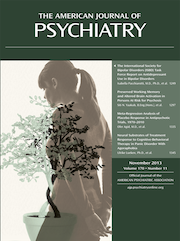Neural Substrates of Treatment Response to Cognitive-Behavioral Therapy in Panic Disorder With Agoraphobia
Abstract
Objective
Although exposure-based cognitive-behavioral therapy (CBT) is an effective treatment option for panic disorder with agoraphobia, the neural substrates of treatment response remain unknown. Evidence suggests that panic disorder with agoraphobia is characterized by dysfunctional safety signal processing. Using fear conditioning as a neurofunctional probe, the authors investigated neural baseline characteristics and neuroplastic changes after CBT that were associated with treatment outcome in patients with panic disorder with agoraphobia.
Method
Neural correlates of fear conditioning and extinction were measured using functional MRI before and after a manualized CBT program focusing on behavioral exposure in 49 medication-free patients with a primary diagnosis of panic disorder with agoraphobia. Treatment response was defined as a reduction exceeding 50% in Hamilton Anxiety Rating Scale scores.
Results
At baseline, nonresponders exhibited enhanced activation in the right pregenual anterior cingulate cortex, the hippocampus, and the amygdala in response to a safety signal. While this activation pattern partly resolved in nonresponders after CBT, successful treatment was characterized by increased right hippocampal activation when processing stimulus contingencies. Treatment response was associated with an inhibitory functional coupling between the anterior cingulate cortex and the amygdala that did not change over time.
Conclusions
This study identified brain activation patterns associated with treatment response in patients with panic disorder with agoraphobia. Altered safety signal processing and anterior cingulate cortex-amygdala coupling may indicate individual differences among these patients that determine the effectiveness of exposure-based CBT and associated neuroplastic changes. Findings point to brain networks by which successful CBT in this patient population is mediated.



